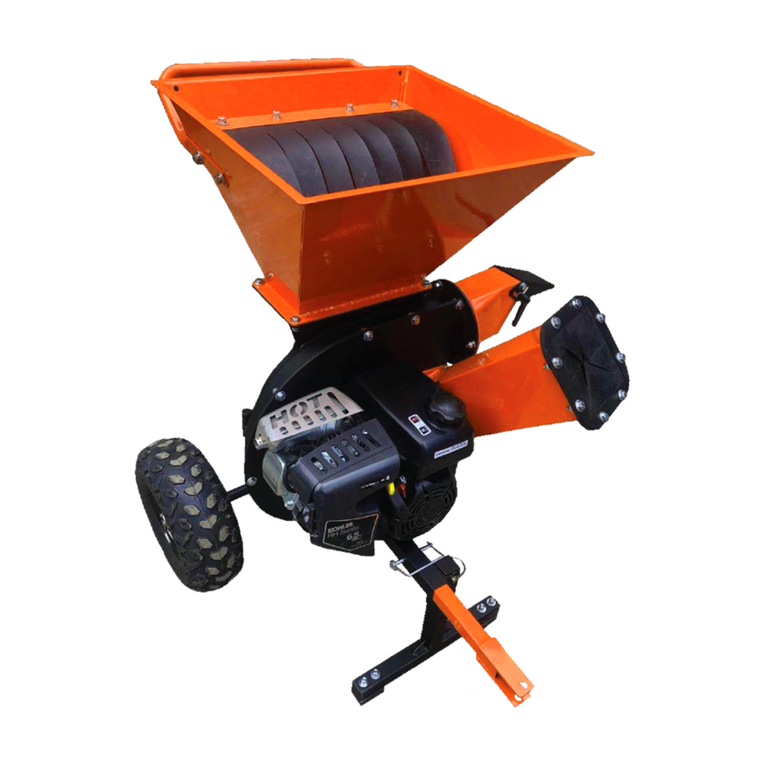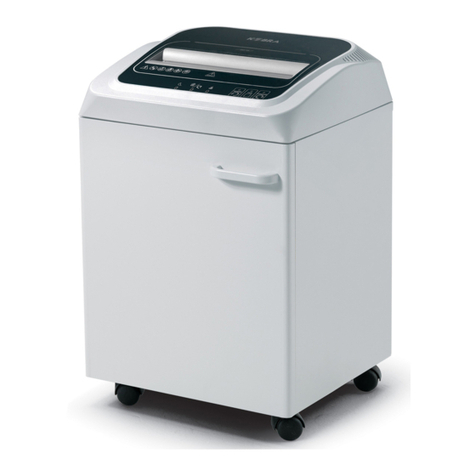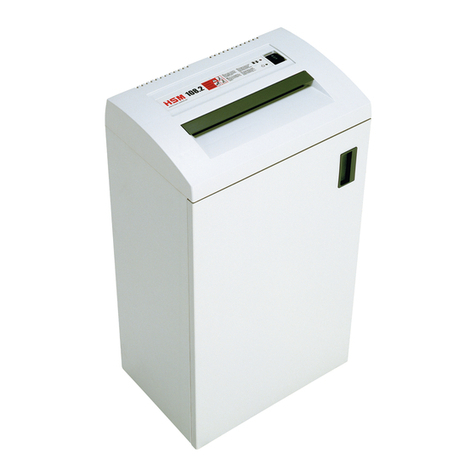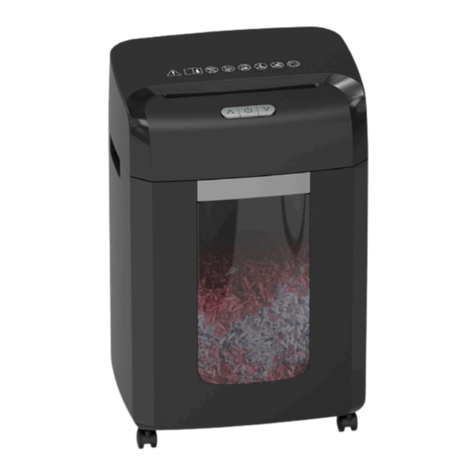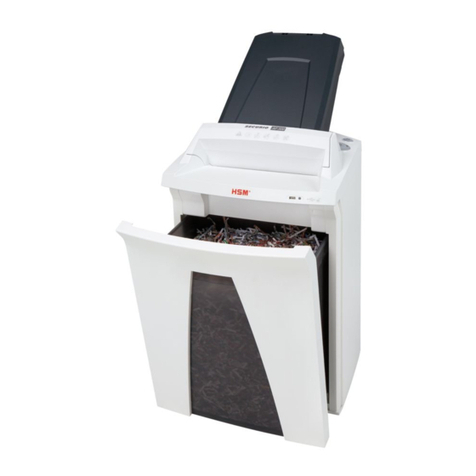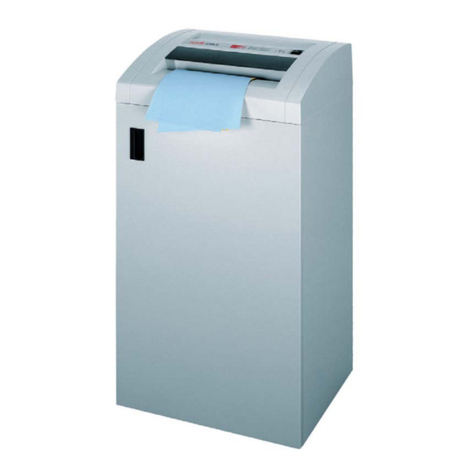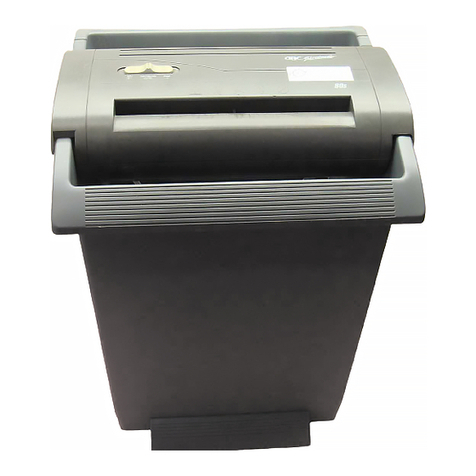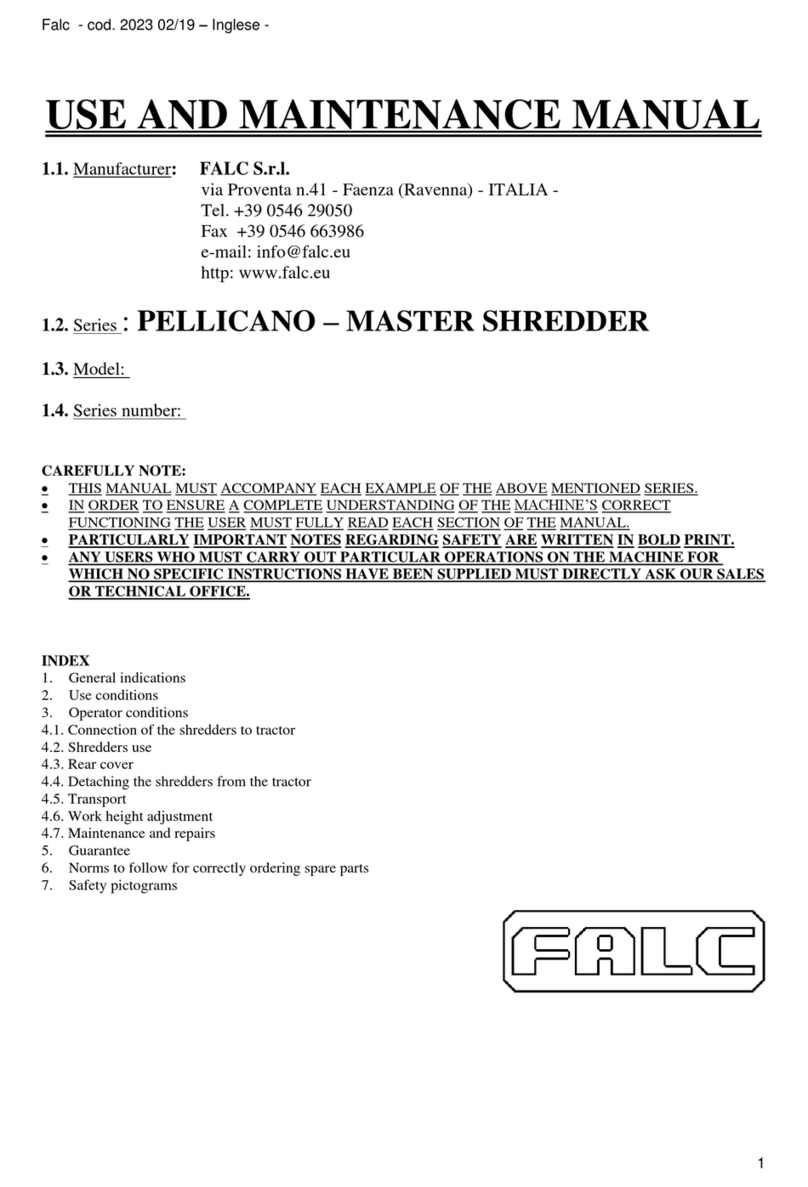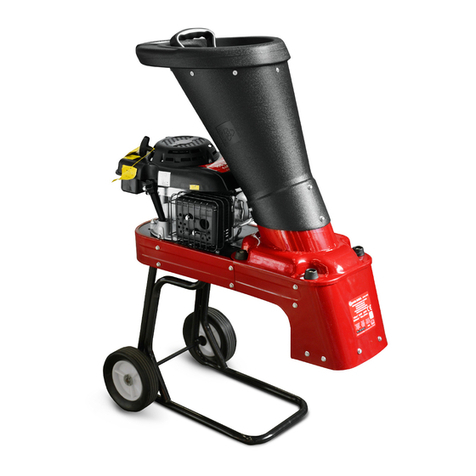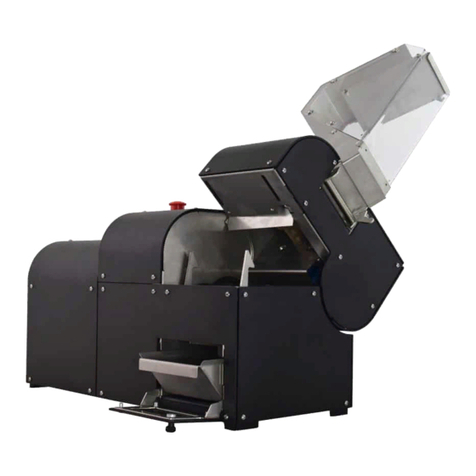Deutscher 650 User manual

Recycle all your Green Waste
CHIPPER SHREDDER 650
Operation and Maintenance
Manual

2
General Description
Initial Assembly
Safety Procedures
Decals
Storage & Transporting
Pre-Start Checks and Starting
Chipping
Shredding
Maintenance
Spare Parts and Warranty
INDEX
3
4
5
7
8
9
10
11
12
16

3
GENERAL DESCRIPTION
The Deutscher Chipper Shredder is designed to chip branches up to 65mm diameter and shred a range of garden
waste including branches up to 12mm diameter. A Swedish Viking steel chipper blade attached to a rotating disc
behind the chipper tube does the chipping, and 9 hardened steel flails inside the shredding chamber rotate at high
speed to shred lighter material which is dropped into the hopper. Material does not exit the unit until it is small
enough to pass though the holes in the internal perforated grate. Most material will not clog the perforated grate.
A bar grate for processing soft vegetable matter is available as an optional extra. A clutch has been fitted to allow
easy starting.
Engine fuel cap
Engine oil fill hole/
dipstick under cap
Engine oil drain
Belt guard
Discharge deflector
Hopper
Clutch lever, at rear
Chipper tube
Deflector pin
Upper grate pin
Shredding chamber
Lower grate pin

4
THE FOLLOWING INSTRUCTIONS APPLY WHEN THE UNIT HAS NOT BEEN ASSEMBLED.
1. Do not put oil into the engine until the unit is assembled.
2. Remove the discharge deflector, then lower the shredding chamber onto its front as shown
below. Fit the front leg using the four countersunk screws provided.
3. Important. The screws must be fitted from the inside of the chamber, with spring washers
and nuts on the outside of the chamber.
4. Fit the rear axle assembly using four 20mm bolts and nyloc nuts. Attach the wheels using 4
plain washers and 2 “E” Clips
5. Put the shredding chamber onto its wheels, then attach the discharge deflector. The clutch
handle can now be attached. The washers are placed either side of the lever, then attach the
nyloc nut. The nyloc nut must not be fully tightened, or the lever will not move.
6. Attach the hopper using the two 10mm nyloc nuts provided. See below.
7. Fill the engine with 600mm of SAE 30 grade oil. Check the level is correct by using the dipstick.
See also the engine manual, supplied. Add unleaded petrol to the fuel tank.
8. WARNING WHEN HANDLING PETROL, KEEP AWAY FROM ANY NAKED FLAMES, THIS
INCLUDES THE PILOT LIGHT ON GAS APPLIANCES. PETROL FUMES ARE HIGHLY VOLATILE.
9. Become familiar with this booklet before starting or operating the chipper shredder.
INITIAL ASSEMBLY

5
SAFETY PROCEDURES
Preparation
1. Do not allow children to operate this equipment.
2. Do not operate this equipment in the vicinity of bystanders.
3. Do not run the unit in an enclosed area since the exhaust from the engine contains some
carbon monoxide, which is a colourless, odourless, tasteless and poisonous gas.
4. Wear safety glasses and hearing protection at all times when operating the machine
5. Avoid wearing clothing that is loose fitting or has hanging cords or ties.
6. Only operate the machine in open space, not close to a wall or other fixed object, and on a
firm, level surface.
7. Do not operate the machine on a paved or gravel surface, where ejected material could
cause injury.
8. Before starting the machine, check that all screws, nuts, bolts, and other fasteners are
properly secured and that guards and screens are in place.
9. Replace damaged or unreadable labels.
10. Use extra care in handling fuels. They are flammable and the vapours are explosive. The
following points should be observed:
• Use only an approved container.
• Never remove the fuel cap or add fuel with the power source running. Allow engine and
exhaust components to cool before refuelling.
• Do not smoke.
• Never refuel the machine indoors.
• Never store the machine or fuel container inside where there is an open flame, such as
a water heater.
• If fuel is spilled, do not attempt to start the power source, but move the machine away
from the area of spillage before starting.
• Always replace and securely tighten the fuel cap after refuelling.
• If the fuel tank is drained, this should be done outdoors.

6
Operation:
1. Before starting the machine, look into both the chipper tube and the hopper to ensure they
are empty.
2. Keep tour face and body away from the feed intake opening.
3. Do not allow hands or any other part of the body or clothing inside the hopper, chipper tube,
discharge area, or near any moving part.
4. Keep proper balance at all times. Do not overreach. Never stand at a higher level than the
base of the machine when feeding material into it.
5. Always stand clear of the discharge area when operating the machine.
6. When feeding material into the machine be extremely careful that pieces of metal, rocks,
bottles, cans or other foreign objects are not included.
7. If the cutting mechanism strikes any foreign objects or if the machine should start making
any unusual noise or vibration, shut off the power source and allow the machine to stop.
Disconnect the spark plug wire from the spark plug and take the following steps:
• Inspect for damage.
• Check for, and tighten, any loose parts.
• Have any damaged parts replaced or repaired with parts of equivalent specifications.
8. Do not allow processed material to build up in the discharge zone; this may prevent proper
discharge and can result in kickback of material through the feed intake opening.
9. If the machine becomes clogged, shut off the engine and disconnect the spark plug wire
before clearing debris.
10. Keep the engine clear of debris and other accumulations to prevent damage to the engine,
overheating or a possible fire.
11. Keep all guards and deflectors in place and in good working condition.
12. Do not tamper with the engine governor settings; the governor controls the safe maximum
speed and protects the engine and all moving parts from damage caused by over-speeding.
Seek authorised service if a problem exists.
13. Do not move the machine while the engine is running.
14. Shut off the engine using the electrical switch whenever you leave the work area.
15. Do not tilt the machine while the power source is running.
16. Even when wearing safety glasses, do not look into the hopper and push the rubber flap
aside while the machine is running. Material can be ejected at high speed.
SAFETY PROCEDURES

7
DECALS
The decals shown below are attached to each new machine. It is the operators responsibility to
ensure these decals are in place and legible. They can be purchased from Deutscher Mowers
Pty Ltd as a set. See “Spare Parts”, in this manual.
On the discharge chute and
beside the chipper tube.
On the side of hopper.
On belt guard near clutch lever. On the rear of the machine, below the hopper.
On the front of the hopper.

8
Always allow the machine to cool before storing.
Store the machine in a dry area away from children and where petrol vapours cannot be ignited
by a spark, such as a welder, or a flame from say the pilot light in a gas appliance.
When storing the unit for longer than three months, it is a wise practice to run the fuel tank dry
beforehand. Fuel can lose volatiles and become ”stale” when left in the tank. This may prevent
starting in the future.
STORAGE & TRANSPORTING
Warning: As stated above, never move the unit when it is running.
1. To move the unit around the garden, stand at the back of the unit facing the lowest edge
on the top of the hopper. Grasp the hopper by both sides using both hands, and pull the top
of the hopper towards you until the unit is evenly balanced over the rear wheels. Push the
unit forward; ensuring it remains evenly balanced over the rear wheels. Try not to descend
steep slopes, and maintain a secure footing if you are descending slopes. NEVER DESCEND A
SLOPE WITH A BYSTANDER BELOW YOU. Do not traverse across steep slopes. The unit may
fall sideways.
2. Do not attempt to move the unit up or down stairs unless you are capable of holding the
weight. Always proceed slowly down stairs with the unit below you. Lower the unit onto each
step carefully, to avoid high impact loads on the wheels and axle. When climbing stairs, again
ensure the unit is below you, and walk backwards holding both sides of the hopper firmly.
3. Transporting from one location to another is best accomplished using a trailer behind a car or
a utility. Always tie the unit in place securely. To prevent the unit falling over, it is safer to remove
the hopper. KEEP THE UNIT UPRIGHT, AS OIL WILL SPILL OUT OF THE ENGINE THROUGH THE
EXHAUST OR THE CARBURETTOR, IF IT IS TILTED SIGNIFICANTLY. If the chipper shredder
must be transported in a station wagon or a car boot, it is easiest to remove the hopper and the
engine. If the engine contains oil, it must be transported upright, but the unit can then be laid
on its side. (Removing the legs and the hopper for transport is not a safe option, as the resulting
assembly is “top heavy” and may fall over inside the vehicle.)

9
PRE-START CHECKS & STARTING
• Ensure you are wearing safety glasses and hearing protection.
• Avoid wearing loose fitting clothing.
• Place the machine on a level “dirt or grass” surface.
• Check that all fasteners on the machine are secure and all guards are in place.
• Check engine oil level.
• Ensure the hopper, the shredding chamber and the chipper tube are clear.
• Keep bystanders away.
• Follow safety instructions (above) when filling the fuel tank.
1. Disengage the clutch. Pull the lever up.
2. Turn the fuel tap to “ON”.
3. Switch on the ignition. Push the “ON” end of the red toggle switch inwards.
4. Push the throttle lever to “FAST”. (Rabbit)
5. Move the choke control to “CHOKE”.( Generally not necessary if the engine is hot.)
6. Stand facing the engine control panel and slightly to the right of the panel. With your left hand
holding the top of the hopper and your right hand holding the starting cord handle, swiftly pull
the starting handle to the right. Repeat until the engine starts. If the engine seems to be flooded,
you may need to try a few pulls of the starter with the choke fully off.
7. As soon as the engine fires, start reducing the choke setting.
8. Once the engine sounds stable, and the choke is fully off, slowly push the clutch lever down
until it reaches the end of its stroke.
9. Check that the rotor is spinning by observing the end of the shaft near the chipper tube.
10. Reduce the throttle setting to the position you need for effective machine operation. Large
diameter branches or a heavy shredding load will require full throttle.
IMPORTANT: The clutch is fitted to make starting easier. It may not fully disengage the drive
to the rotor, especially when the drive belt is new. NEVER rely on the clutch to disengage
the drive. ALWAYS switch off the engine and remove the spark plug before clearing a jam or
checking the machine.
STARTING
Control Panel Layout (B&S) Control Panel Layout (Honda)
CHOKE
FUEL TAP
THROTTLE
ON-OFF SWITCH
STARTER HANDLE
6.5

10
Warning! Do not place hands or fingers into the chipper tube. Keep children away from the
machine when it is operating. Never leave the engine running and unattended.
CHIPPING
1. The Deutscher chipper shredder can chip branches up to 65mm diameter. Should a branch
contain sharp bends, the bends can be cut 2/3 through with a bow saw. Then the branch can be
forced straight and will easily feed into the tube. Very short branch pieces can be processed,
by pushing them in with the next branch.
2. If the machine is slowing significantly as a branch is being processed, reduce the feeding
rate. In this case, the wood may be very dry and hard, or the chipper blade may need sharpening.
See maintenance instructions.
3. The ends of branches with many smaller branches attached, can normally be dropped into
the hopper, providing the largest branch is no greater than 12mm diameter.
4. Some branches have strong bark which peels off as the branches are being chipped, and the
bark then winds around the rotor shaft, causing a bearing to get hot. Rotating branches slowly
as you chip, should solve this problem. DO NOT TRY AND CHIP PALM LEAVES, AS THEY CAN
ALSO CAUSE THE BEARING TO OVERHEAT.
5. If you wish to collect the shredded material, it can be discharged onto a plastic, or similar,
sheet. To collect the material, simply switch off the machine, move it backwards off the sheet,
and pick up the sheet by its four corners.
Please note: The machine should not be tilted while it is running, as the engine may seize.
6. If you notice the rotor is not turning, by looking at the end of the shaft next to the chipper
tube, and if the clutch lever is in the “engaged” position, then the shredding chamber may be
clogged or the belt may need tightening or replacing. See maintenance instructions. Similarly,
if you can smell the belt burning, it will need adjusting or replacing. STOP THE UNIT AS SOON
AS ANY OF THESE FAULTS ARE DETECTED. YOU MAY SAVE THE BELT. See next section for
clearing a blocked shredding chamber.
7. In the unlikely event that a branch becomes jammed in the chipper tube, stop the machine
and disconnect the spark plug lead from the spark plug. You may need to remove the hopper so
you can rotate the rotor by hand, to disconnect the chipper blade from the branch. Use a pair of
pliers, a screwdriver or similar tool to withdraw the branch out of the chipper tube.

11
SHREDDING
Warning! In general, materials will “self fed” into the hopper. Do not push material into the
hopper with your hands. Use a light green branch (no larger than 20mm diameter) or a piece
of softwood. If materials are jammed, a safer practice is to turn off the machine, remove the
offending material, restart and feed it in again.
Warning! Wear eye protection and hearing protection. Although every effort has been made
to reduce the velocity of chips that may fly back up the hopper, we could not test every variety
and shape of wood. It is therefore a wise operating practice to keep your head out of the
opening.
Warning! Be extremely careful that you do not inadvertently collect metal, bottles or other
hard objects when you pick up material to drop into the hopper. The hard material may fly
back, or it may even break components inside the machine.
1. Branches smaller than 12mm diameter, leaves, weeds and other organic material can be
shredded. If you notice that the material is not coming out the discharge chute, then the rotor
is jammed or the grate is blocked. To unblock the grate or to free the rotor, turn off the engine,
disconnect the spark plug lead from the spark plug, pull out the top grate pin, raise or remove
the discharge deflector, lower the screen and remove the offending material from the shredding
chamber. Replace all components before restarting.
2. Should the grate continue to block, try mixing some dry material or small branches with the
soft material being shredded. If this also fails, you may consider purchasing our optional bar
grate. The bar grate replaces the perforated grate, and is held in place with the same two
pins.
3. Be very careful when feeding branches into the hopper, as they can rush out of your hands
in an instant. NEVER WRAP MATERIAL AROUND YOUR HANDS. ALWAYS BE PREPARED TO
INSTANTLY RELEASE THE MATERIAL. DO NOT SHRED PALM LEAVES. LONG MATERIAL
SUCH AS VINES SHOULD BE CUT INTO LENGTHS NO LONGER THAN 500mm.
4. Do not allow the discharged material under the machine to build up to the point where it
is preventing further material from being discharged. Never put your hands or feet under the
machine when it is running. Use an implement or a stick to push material aside.
5. Control the rate of feeding the hopper to minimise large changes in engine speed. This will
ensure your belt lasts longer and may prevent a blocked shredding chamber or a clogged
hopper.

12
MAINTENANCE
BASIC MAINTENANCE
Tools required :
5mm Allen Key (chipper blade replacement)
13mm ring / open ended spanner.
17mm ring / open ended spanner
General
When the machine is stopped for servicing, inspection, or to change an accessory, shut
off the engine, disconnect the spark plug wire from the spark plug and make sure that all
moving parts have come to a complete stop. Due to the magneto starting system, the engine
may start when the cutting means is moved unless the ignition switch is off and the spark
plug wire is removed from the spark plug. Never rely on the clutch to positively disengage
the drive mechanism. Allow the machine to cool before making any inspections, adjustments
etc.
Oil check and replacement
The engine oil level should be checked regularly, every 4 hours of operation. For oil
replacement, see the engine booklet.
Air filter cleaning
Check the condition of the air cleaner regularly, in dusty conditions every 4 hours. See
engine book for cleaning details.
Drive belt adjustment / replacement
The drive belt may become loose after an initial settling in period, after very heavy loads
have been applied or after an extended period of use. You can see if the belt is slipping
by observing the end of the rotor shaft, adjacent to the chipper tube. When “slipping” is
observed, do not continue to use the machine. Tighten the belt as follows:
• Switch off the engine and remove the spark plug lead from the spark plug.
• Using a 13mm spanner, remove the plastic belt guard.
• Observe the condition of the belt. If it is severely frayed or has a burnt section, it will need
to be replaced.
• Loosen the nut (1) furthest from the belt on the threaded rod attached to the clutch lever,
using a 13mm open ended spanner. See sketch below.
• With the clutch lever in the “up position, wind the nut (1) about 2mm away from the
adjacent boss (3), then wind the other nut (2) outwards until both nuts are firmly in contact
with the boss.
• Push the clutch lever down fully and check the belt tension. The far side of the belt should
deflect about 12 mm when pushed firmly inwards. See sketch below.
• If the belt is not yet tight, repeat the process.
• Should you run out of adjustment, the belt will need to be replaced.
• Tighten both nuts against the boss, then replace the plastic belt guard. Do not over-
tighten the belt guard nuts, or you will distort the guard.
• To replace a belt, simply wind nut (2) fully inwards and replace the belt by winding it onto
the two pulleys. IMPORTANT: ENSURE THAT THE BELT IS INSIDE THE TWO BELT GUIDE
PINS THAT ARE ATTACHED TO THE SIDE PLATE OF THE ENGINE. FAILURE TO CHECK THIS
COULD RESULT IN A RUINED BELT. Adjust the belt tension as described above.

13
MAINTENANCE
The chipper blade will become blunt with extended use, particularly if you are chipping dry
hardwood. You can feel when the blade is blunt, as the processing time is longer and the
engine is more likely to slow down under heavy loading. To sharpen the blade:
• Switch off the engine and remove the spark plug lead from the spark plug.
• Using a shifting spanner, remove the two 10mm bolts that hold the hopper in place. Do not
lose the spring washers. Remove the hopper.
• Using a 13mm spanner, remove the small maintenance cover plate, adjacent to the chipper
tube.
• With the clutch lever disengaged, turn the rotor until the chipper blade is opposite the
opening created by removing the cover.
• Using a nail or a similar sharp object, clean the allen key holes in the two countersunk
screws that retain the chipper blade.
• With the 5mm allen key on the outside and a 13mm spanner on the inside, remove the two
screws that secure the chipper blade to the rotor disc.
• Remove and inspect the chipper blade. The edge can be sharpened using a fine grinding
wheel. It should be sharpened at 45 degrees to the top surface. Remove only a minimum
of material, until you feel that the edge is sharp. Initially the blade is 32mm wide. With
repeated resharpening, the blade will reach 30mm wide. At this time it should be replaced,
as the rotor will not be in balance.
• Before refitting the chipper blade, clean the surface of the disc behind the blade and
ensure that the blade is sitting flat on the sloping machined surface. Replace the two
screws if they appear worn or damaged. Always use new 8mm nyloc nuts and tighten them
securely. DO NOT USE PLAIN 8MM NUTS. THE CHIPPER BLADE COULD FLY OUT OF THE
CHAMBER OR SMASH INTO THE CHIPPER TUBE IF THE BOLTS BECOME LOOSE.
• When replacing the chipper blade, always use new screws and nuts.
• Rotate the rotor disc slowly by hand, and check that the chipper blade does not hit the
inside end of the chipper tube.
• Replace the maintenance cover plate and the hopper.
Chipper blade replacement/ sharpening
12mm deflection
(3)
Drive belt
(2)
(1)
UP

14
MAINTENANCE
DETAILED MAINTENANCE
Tools Required:
1/8” Allen Key
8mm ring spanner and small socket spanner.
18mm open ended spanners.
Double ended bearing puller may also be needed.
Shifting spanner, 200mm approx.
Philips screwdriver with a shaft at least 210mm long, or a _” pin at least 250mm long.
General
The rotor assembly should be inspected after every 20 hours of use or after a solid impact,
by removing the hopper. Should any parts appear badly worn, cracked or bent, they must
be replaced before the machine is used again. Always replace the flails and/or the rotor
spacers in sets, to keep the rotor in balance.
The flails can be rotated if they are worn on one side.
Removal and replacement of the flails
• Switch off the engine and remove the spark plug lead from the spark plug.
• Remove the hopper and the maintenance cover plate.
• Disengage the clutch.
• Remove the two bolts from one of the flail rods, then align the rod with the 7mm hole in the
side plate. The hole is normally obscured by the belt guard, and is opposite the maintenance
cover hole.
• Push the shaft of a Philips screwdriver through the 7mm hole and drive the flail shaft out
the opposite side plate of the machine, through the maintenance cover hole. You may need
to tap the end of the screwdriver.
• Collect all the flail components and place them in a separate pile.
• Select the other two flail shafts in turn and repeat the operation, keeping the parts
separate.
• Inspect all parts for significant wear or cracks. Replace any faulty parts.
• When re- assembling, it is wise to swap the flail shafts to another location, so the flails
wear the rods at different points. Observe the diagram below to ensure you place the flails
in the correct position. It is particularly important that the flail against the chipper disc is on
the rod opposite the chipper blade. See (A) below.
• Replace the bolts if any wear or damage is observed. This includes the threads.
• Always replace the six 5mm nyloc nuts.
Flat Rod
Flail
Chipper
Disc
Chipper
Blade
4
4
4
4
3
3
2
2
1
1

15
MAINTENANCE
• Engine Replacement
• Switch off the engine and remove the spark plug lead from the spark plug.
• Remove the hopper.
• Remove the discharge deflector.
• Remove the belt guard.
• Undo the four 8mm engine bolts using 13mm spanners.
• Remove the drive belt.
• Lift the engine off the machine.
Rotor Removal
• Remove the engine as described above.
• Remove the front and rear legs from the shredding chamber.
• Undo the boss screws on the rotor pulley.
• Using a puller, remove the pulley from the rotor shaft.
• Undo boss screws on rotor bearing each side of rotor
• Take the 8mm bolt from the end of the rotor shaft, on the chipper tube side.
• Undo the seven 10mm nuts securing the chipper tube side plate to the engine mounting
plate and the curved back plate. Undo the two 8mm bolts securing the chipper tube plate to
the small plate under the engine mounting plate.
• Tap the chipper tube plate off the shredding chamber using a plastic hammer.
• Tap the rotor through the back bearing using a plastic hammer.
• Inspect the bearings for signs of overheating, loss of grease, looseness or “lumpy”
operation when turned. Inspect also the fit of the bearings in the housings. They must be a
very firm sliding fit. Replace bearings and housings unless they appear perfect.
• Also inspect the keyway on the rotor shaft, for the pulley. Repair the keyway if it appears
damaged, or replace the rotor.
Note. When re-assembling, use a thread locking compound on the pulley boss screws and
replace the key if it appears worn. After assembly, check that the chipper blade does not
contact the inside end of the chipper tube by rotating the rotor by hand.
ROTOR SPACERS
Spacer No. Part Number Length mms. Quantity
1 3180 18 2
2 3179 36 2
3 3181 51 (with hole) 2
4 3182 51 (no hole) 4

COMMONLY USED SPARE PARTS
Part No. Part Description Qty per Part No. Part Description Qty per
3153 Wheel 2 3130 Hopper (Plastic) 1
3116 Grate Assembly (19mm hole) 1 3131 Pulley Guard 1
3158 Linch Pin 1 3174 Rotor Bearing 2
3161 Vee Belt 1 3175 Rotor bearing Housing 2
3114 Engine Pulley 1 3112 Chipper Blade 1
3163 Idler pulley 1 3178 Screw Tapered 2
3164 Idler pulley Arm 1 1099 M8 Nyloc Nut 2
3169 Belt tension adjustor 1 3121 Flail Shaft 3
3129 Rubber flap 1 3111 Flail Blade 9
3150 Rear axle assembly 1 3187 Decal Set 1
1314 E Clip (16mm) 2
• DEUTSCHER MOWERS PTY. LTD. Will warrant the repair or replacement, free of charge, any
parts of the chipper shredder, that are defective in materials or workmanship or both for a
period of
• 24 months from the date of purchase domestic warranty
• 12 months from the date of purchase commercial warranty
• This does not cover normal wear, abuse or incorrect servicing procedures as set out in the
owners manual. Parts such as blades, blade bolts, tyres and v-belts, which can be subject to
use beyond their normal intended working capacity are also excluded.
• This warranty is void if non genuine parts have been used or if repairs or modifications have
been made without the manufactures written authority.
• This warranty does not obligate the manufacturer, its agents or dealers to cover transport
costs incurred in the repair or replacement of any defective part.
• The engine on this unit is covered by the engine manufactures warranty supplied with the
unit. For your nearest engine dealer, Phone: Briggs & Stratton: 1800 650 042 or Honda M.P.E.:
1800 809 327
WARRANTY POLICY:
All claims to be referred to Deutscher Mowers Pty Ltd
Telephone : 03 5339 5708 Fax: 03 5339 3189 Email: [email protected].
FOR YOUR RECORD
Model: Serial Number:
Date of Purchase: Purchased From:
Remember: Proof of purchase is the responsibility of the owner and is necessary prior to warranty
work being under taken. An authorised dealer using genuine spare parts must carry out repairs or your
warranty will be void.
Telephone : Fax: Email:
Manufactured in Australia by: DEUTSCHER MOWERS PTY LTD, 711 Creswick Road, Ballarat 3350
Booklet No. Edition: 1 Feb 2007
Other manuals for 650
1
Table of contents

